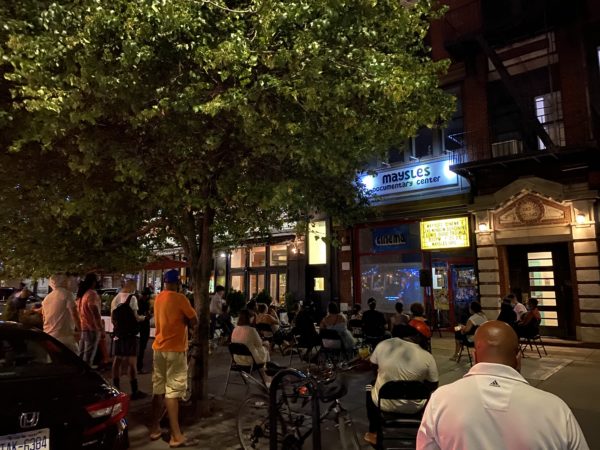New York City has no shortage of independent and art house theaters—but Harlem’s Maysles Documentary Center is something different. The Maysles was established by late documentary pioneer Albert Maysles in 2008 as a place to explore and discuss documentary films. Core to the its mission are conversation and community involvement—made more complicated by a pandemic that’s shut the theater’s doors and driven many of its customers inside. But the Maysles forges ahead, never forgetting the community that it’s here to serve.
On Saturday, July 25 the Maysles took advantage of their copious sidewalk space (a rarity for New York City) to host an outdoor, socially distanced screening of John Lewis: Good Trouble, about the late Congressman. The event was the first in the Maysles’ planned Sidewalk Cinema series—a “spontaneous, slightly guerrilla” bit of programming, explains Executive Director Dale Dobson, that caters to “people on a sidewalk in New York trying to find some normalcy [in] their lives through the kinds of things that they enjoy doing.” Future Sidewalk Cinema events, explains Programmer and Cinema Manager Allason Leitz, will be kept intentionally small, with seats laid out solo or in small groups so that people—whether they’re intentionally coming out to the Maysles or just passing by on still-busting Lenox Ave.—can stop and see a movie on the screen hung in the Maysles’ front window.
A subsequent Sidewalk Cinema event took place on August 1, and another—a screening of River City Drumbeat, about an African-American drum corps in Louisville, Kentucky—on Friday, August 14. For Dobson, a major part of the series’ appeal is that it allows the theater “to make certain that people within the local community are getting something that they’re accustomed to from us.”
Since shutting down in March, the Maysles—like many other art house cinemas across the United States—has provided content digitally, offering online film screenings as well as shifting their educational programming online. But to offer only online programming, Leitz explains, runs counter to the Maysles’ goal of “bringing in people from across economic backgrounds in Harlem.” In normal times, the Maysles runs on suggested donations; as long as there are open seats, no one is turned away for lack of money. But with digital programming, the money and technological knowledge required to access the Maysles’ virtual theatrical platform provide an automatic limitation. Sidewalk Cinema, Leitz continues, “has been a way for us to equalize, as much as we can,… who has access right now.”
“It’s really important to our mission that we serve our local community,” argues Dobson. “And if the local community doesn’t have the tools, that’s concerning.” To that end, the Maysles is exploring additional ways to provide in-person screenings, both in Harlem and elsewhere in the city, potentially by collaborating with outside groups. Meanwhile, the Maysles’ virtual programming continues—and provides opportunities that this small, 51-seat theater didn’t have before.
Traditionally, Dobson explains, “it’s difficult for a cinema like ours to do a lot of first-run docs” due to high licensing fees; now, with the digital business model operating “more like a rev share,” the Maysles has been “able to [program] some of those best-in-class, theatrical docs, particularly [ones] that would be of interest to a POC audience.” And the audience itself has expanded; Dobson was surprised to see, on attending a digital documentary and poetry workshop held in May, that there were participants from “Ireland and Romania—all these parts of the world.”
While digital has opened some doors for the Maysles, it’s also somewhat flattened the cinema landscape, Dobson argues. Without the physical atmosphere and little theatrical extras, like the intimate Q&As that were a key part of the Maysles experience, there’s not as much to separate one theater from another, especially if there’s a lot of overlap in programming. The key, then, is not abandoning the Maysles’ highly curatorial approach in favor of slapping a bunch of stuff up online and hoping your audience will respond to it. “We needed to make sure,” Dobson notes, “that we carried the essence of what people look for in our curation into the digital space…. The curation of the programming [needs to have] the certain quality that we’ve been known for for over a decade.”
The Maysles’ curatorial approach to programming allows them to be involved in conversations taking place surrounding issues of racial justice, even at a time when their doors are closed. The cinema’s first outdoor event—a Live VJ set that took place in mid-July—brought together audio and video from the Harlem Renaissance through the modern day to encourage contemplation and conversation about how lessons from the past can inform a fight for a new future. And the concept of Western civilization—and its roots in imperialism and conquest—is interrogated in the Maysles’ After Civilization series, made up of 12 films (some with accompanying Zoom Q&As) and pairing documentary with science-fiction elements.
After Civilization, like much of the Maysles’ online programming, is pay-what-you-can. Indoor screenings, when the Maysles could still hold them, operated on a suggested donation basis. “The bulk of how we work as an organization is through grants,” Dobson explains. People are still donating to the theater, which she is “pleasantly surprised” by, and the Maysles has received some emergency money, as well. But the life of a non-profit remains a “constant cycle” of securing funding—something that hasn’t changed, even if the rest of the exhibition landscape has. “What I really think has been beautiful this year,” argues Dobson, “is I’ve seen us really come together and work harder. I’ve never seen my board work as hard. I’ve never seen my staff work as hard before…You’re in such uncharted terrain. You have no playbook.”



Share this post